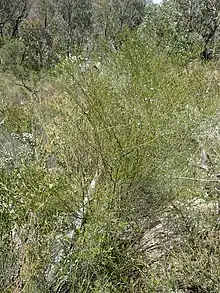| Hemigenia cuneifolia | |
|---|---|
 | |
| In Girraween National Park | |
| Scientific classification | |
| Kingdom: | Plantae |
| Clade: | Tracheophytes |
| Clade: | Angiosperms |
| Clade: | Eudicots |
| Clade: | Asterids |
| Order: | Lamiales |
| Family: | Lamiaceae |
| Genus: | Hemigenia |
| Species: | H. cuneifolia |
| Binomial name | |
| Hemigenia cuneifolia | |

Hemigenia cuneifolia is a plant in the family Lamiaceae and is endemic to eastern Australia. It is a shrub with oblong leaves arranged in whorls of three, and blue to mauve flowers.
Description
Hemigenia cuneifolia is a shrub that typically grows to a height of about 2.5 m (8 ft 2 in). The leaves are oblong, 15–30 mm (0.59–1.18 in) long, 2–4 mm (0.079–0.157 in) wide on a petiole 2–6 mm (0.079–0.236 in) long and arranged in whorls of three. The sepals are fused to form a tube 4–5.5 mm (0.16–0.22 in) long with five lobes that are shorter than the tube. The petals are blue to mauve, about 8 mm (0.31 in) long and fused to form a tube with two lips. There are four stamens, the lower two more or less sterile, and the style has two branches. Flowering mainly occurs from August to April.[2][3]
Taxonomy and naming
Hemigenia cuneifolia was first formally described in 1870 by George Bentham and the description was published in Flora Australiensis from specimens collected by William Woolls and Hermann Beckler.[4][5]
Distribution and habitat
Hemigenia cuneifolia grows in forest from south east Queensland to the Hill Top area of New South Wales and as far inland as the Pilliga Scrub.[2]
References
- ↑ "Hemigenia cuneifolia". Australian Plant Census. Retrieved 10 November 2020.
- 1 2 Conn, Barry J. "Hemigenia cuneifolia". Royal Botanic Garden Sydney. Retrieved 10 November 2020.
- ↑ Conn, Barry J. "Hemigenia". Royal Botanic Garden Sydney. Retrieved 10 November 2020.
- ↑ "Hemigenia cuneifolia". Australian Plant Name Index. Retrieved 23 March 2020.
- ↑ Bentham, George (1870). Flora Australiensis (Volume 5). Vol. 5. London: Lovell Reeve & Co. pp. 118–119. Retrieved 10 November 2020.